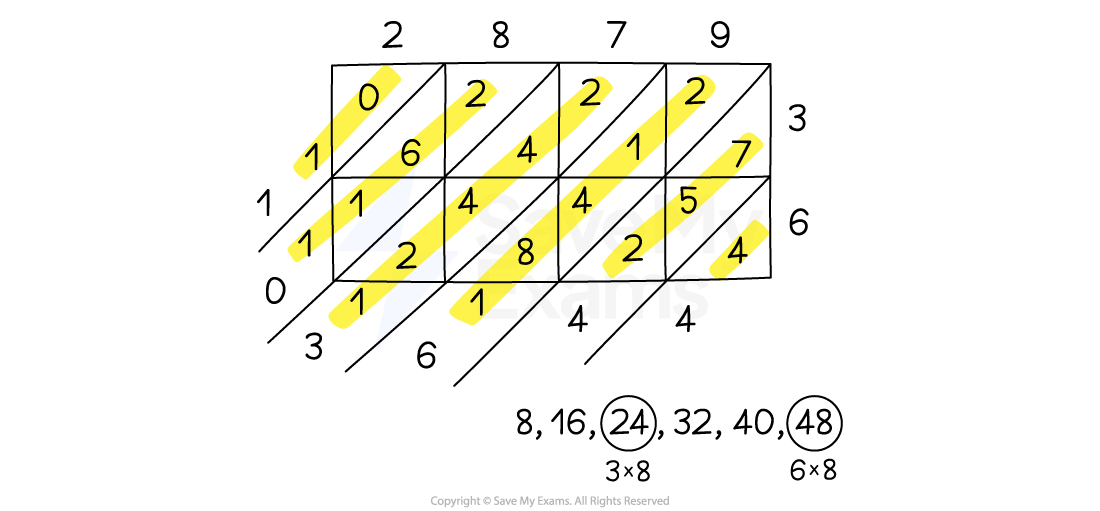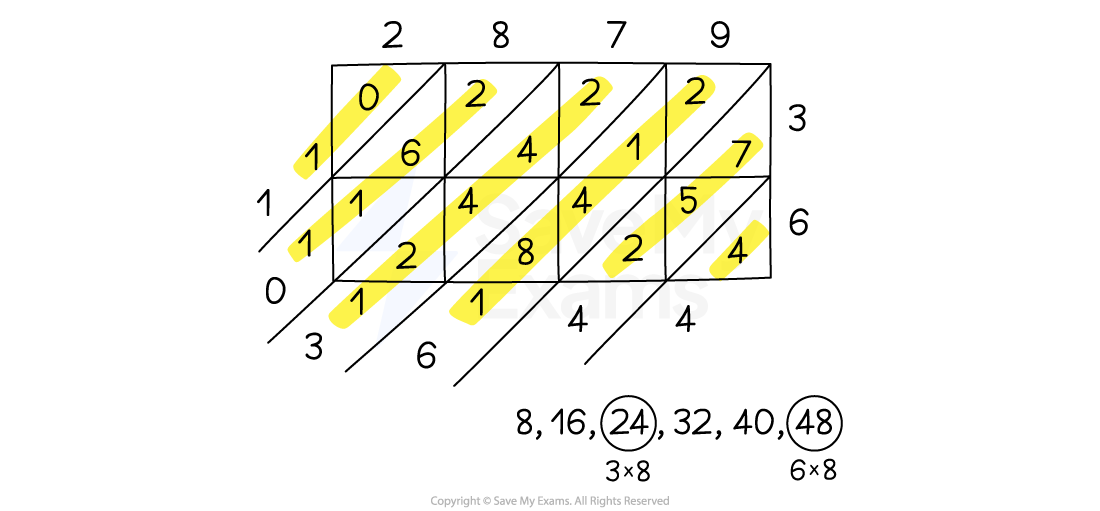Multiplication & Division (OCR GCSE Maths): Revision Note
Exam code: J560
Did this video help you?
Multiplication
How do I multiply two numbers without a calculator?
There are a variety of written methods that can be used to add large numbers
You only need to know one method, but be able to use it confidently
Four common methods are described below, but there are many other valid methods
How do I use the column method?
This is an efficient method if you are confident with multiplication
To use the column method:
Write one number above the other lining up the digits using place value columns
Multiply the first digit (on the right) from the bottom value by each digit in the top value
Write the result under the line with the digits in the correct place value columns
Multiply the next digit in the bottom value by each digit in the top value
Always work from right to left
Use 0s as place holders when multiplying digits in columns other than the ones column
For example, 87 × 426 = 37 062
How do I use the lattice method?
The lattice method is good for numbers with two or more digits
This method allows you to work with individual digits
To use the lattice method:
Draw a grid
The number of rows should be the same as the number of digits in one number
The number of columns should be the same as the number of digits in the other number
Draw diagonal lines through the boxes
Multiply each pair of digits, writing the result in the relevant box
Ones should be written in the bottom half of the box and tens in the top half of the box
Add the digits along the diagonals and write the result in the diagonal outside the grid
Carry the tens of any 2 digit result into the next diagonal
For example, 3516 × 23 = 80 868

How do I use the grid method?
This method keeps the value of the larger number intact
It may take longer with two larger numbers
Be careful lining up numbers with lots of zeros!
To use the grid method
Draw a grid
The number of rows should be the same as the number of digits in one number
The number of columns should be the same as the number of digits in the other number
Label the rows and columns with the values of each digit
E.g. For 3516 you would use 3000, 500, 10 and 6
Multiply together the relevant values and put the results in the boxes
Add up all of the cells in the boxes
For example, 3516 × 7 = 24 612


How do I use the repeated addition method?
This is best for smaller, simpler cases
You may have seen this called ‘chunking’
To use the repeated addition method
Build up to the answer using simple multiplication facts that can be worked out easily
To find 13 × 23 :
1 × 23 = 232 × 23 = 46
4 × 23 = 92
8 × 23 =184
So, 13 × 23 = 1 × 23 + 4 × 23 + 8 × 23 = 23 + 92 + 184 = 299
What words are used for multiplication and division?
Multiplication may be phrased using the words lots of, times or product
Division may be phrased using the words quotient, share and per
Examiner Tips and Tricks
A good way to check your answer without a calculator is to estimate it (e.g. by rounding everything to 1 significant figure)
Worked Example
Multiply 2879 by 36.
As you have a 4-digit number multiplied by a 2-digit number then the lattice method is a good choice
Start with a 4×2 grid.…

Notice the use of listing the 8 times table underneath to help with some of the multiplication within the lattice
Use an estimate to check your answer; 3000×40 is equal to 120 000
2879 × 36 = 103 644
Did this video help you?
Division
How do I divide a number by another without a calculator?
The most common written method for division is short division (or "the bus stop method")
There are other methods such as long division, but short division is generally the most efficient
While short division is best when dividing by a single digit, for bigger numbers you may need a different approach
You can use other number skills to help
eg. cancelling fractions, “shortcuts” for dividing by 2 and 10, and the repeated addition (“chunking”) method covered in Multiplication
Short division (bus stop method)
Unless you can use simple shortcuts such as dividing by 2 or by 10, this method is best used when dividing by a single digit
To find 174 ÷ 3
Starting from the left; 3 fits into 1, 0 times, with a remainder of 1
Carry the remainder of 1 over to the next digit, which forms 17
3 fits into 17, 5 times, with a remainder of 2
Carry the remainder of 2 over to the next digit, which forms 24
3 fits into 24, 8 times, with no remainder
So, 174 ÷ 3 = 58
Factoring & cancelling
This involves treating division as you would if you were asked to simplify fractions
For example, 1008 ÷ 28 can be written as
This can then be simplified
252 ÷ 7 can then be calculated using short division; the answer is 36
Dividing by 10, 100, 1000, … (Powers of 10)
This is a case of shifting digits along the place value columns
For example
380 ÷ 10 = 38.0 (shifts by 1 column)
45 ÷ 100 = 0.45 (shifts by 2 columns)
28 ÷ 1000 = 0.028 (shifts by 3 columns)
For cases like this, it can help to add leading zeros
0028 ÷ 1000 may be easier to visualise
Worked Example
Divide 568 by 8.
This is division by a single digit so short division would be an appropriate method
If you spot it though, 8 is also a power of 2 so you could just halve three times
Using short division, the bus stop method:

8 fits into 5, 0 times, with a remainder of 5
8 fits into 56, 7 times exactly
8 fits into 8, 1 time exactly
Use an estimate to check your answer; 600 ÷ 10 is equal to 60
568 ÷ 8 = 71

Unlock more, it's free!
Did this page help you?